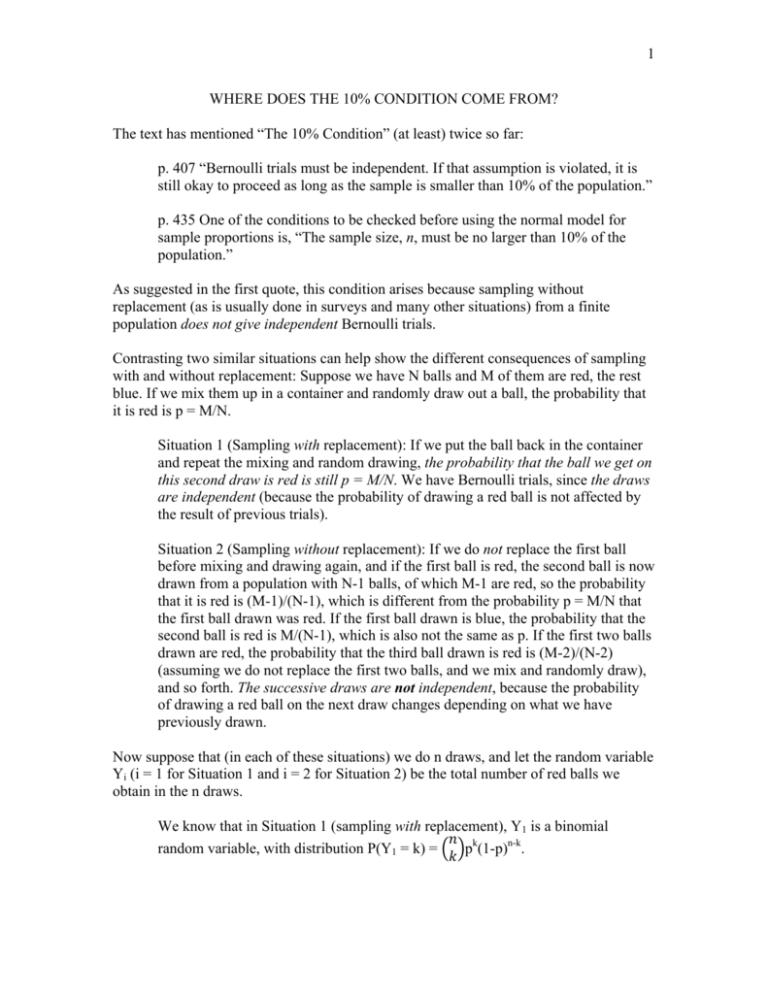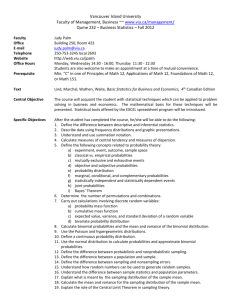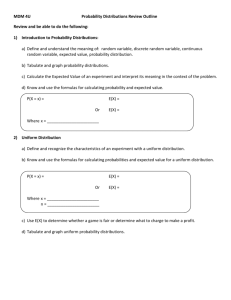
1
WHERE DOES THE 10% CONDITION COME FROM?
The text has mentioned “The 10% Condition” (at least) twice so far:
p. 407 “Bernoulli trials must be independent. If that assumption is violated, it is
still okay to proceed as long as the sample is smaller than 10% of the population.”
p. 435 One of the conditions to be checked before using the normal model for
sample proportions is, “The sample size, n, must be no larger than 10% of the
population.”
As suggested in the first quote, this condition arises because sampling without
replacement (as is usually done in surveys and many other situations) from a finite
population does not give independent Bernoulli trials.
Contrasting two similar situations can help show the different consequences of sampling
with and without replacement: Suppose we have N balls and M of them are red, the rest
blue. If we mix them up in a container and randomly draw out a ball, the probability that
it is red is p = M/N.
Situation 1 (Sampling with replacement): If we put the ball back in the container
and repeat the mixing and random drawing, the probability that the ball we get on
this second draw is red is still p = M/N. We have Bernoulli trials, since the draws
are independent (because the probability of drawing a red ball is not affected by
the result of previous trials).
Situation 2 (Sampling without replacement): If we do not replace the first ball
before mixing and drawing again, and if the first ball is red, the second ball is now
drawn from a population with N-1 balls, of which M-1 are red, so the probability
that it is red is (M-1)/(N-1), which is different from the probability p = M/N that
the first ball drawn was red. If the first ball drawn is blue, the probability that the
second ball is red is M/(N-1), which is also not the same as p. If the first two balls
drawn are red, the probability that the third ball drawn is red is (M-2)/(N-2)
(assuming we do not replace the first two balls, and we mix and randomly draw),
and so forth. The successive draws are not independent, because the probability
of drawing a red ball on the next draw changes depending on what we have
previously drawn.
Now suppose that (in each of these situations) we do n draws, and let the random variable
Yi (i = 1 for Situation 1 and i = 2 for Situation 2) be the total number of red balls we
obtain in the n draws.
We know that in Situation 1 (sampling with replacement), Y1 is a binomial
𝑛 k
random variable, with distribution P(Y1 = k) =
p (1-p)n-k.
𝑘
2
In Situation 2 (sampling without replacement), Y2 is called a hypergeometric
random variable, with distribution P(Y2 = k) =
!
!
!!!
!!!
!
!
.
You may have seen the hypergeometric distribution in M362K. If you haven’t, you might
like to try to derive the formula for P(Y2 = k). [Hint: Think of a sequence of k draws in
order as an outcome. The numerator counts the number of outcomes with exactly k red
draws, and the denominator counts the total number of outcomes.]
Note: If we had an infinite population, with proportion p of “successes” (for example,
consider tosses of a die with one side red, so that p = 1/6 for getting red, a “success”),
then we would also get the binomial random variable Y1, since in this case there is no
distinction between sampling with and without replacement.
The mean and variance of the hypergeometric random variable Y2 are
!
E(Y2) = 𝑛 !
!!!
(1)
!
!
Var(Y2) = !!! 𝑛 ! 1 − !
(2)
Here are a couple of sources for the proofs of equations (1) and (2), in case you’re
interested:
S. Ross, A First Course in Probability, 7th edition, Pearson Prentice Hall, 2006.
Example 8j in Section 4.8.3 (p. 181) gives a proof using definitions and
combinatorial identities.
M. Iltis, Week 4 Notes for Statistics 224, available at
http://www.stat.wisc.edu/courses/st224-iltis/notes4.pdf. This gives a proof (pp. 12
– 13) that starts out in a way similar to the arguments in in the Math Box on p.
410 of the textbook, by writing Y2 as a sum of Bernoulli random variables.
However, the Bernoulli random variables in this case are not independent, which
makes the calculation of the variance a little more complicated.
We will compare these formulas with the corresponding formulas for the expected value
of the binomial random variable Y1 in Situation 1. Recall (from p. 409 or 410 of the
textbook) that
E(Y1) = np
Var(Y1) = np(1-p)
!
Since p = ! , the binomial random variable Y1 and the corresponding hypergeometric
random variable Y2 have the same mean.
3
Comparing the formulas for the variances of the binomial random variable Y1 and the
!
corresponding hypergeometric random variable Y2, (remembering that p = ! ), we see
that
!!!
Var(Y2) = !!! Var(Y1)
(3)
!!!
The factor !!! is called a finite population correction factor, since (by the comment
toward the top of p. 2 above), if the population were infinite, we would have the random
variable Y1.
Consequences of Equation (3):
1. Since N – n < N -1, the finite population correction factor is less than 1. In other
words, the variance when sampling without replacement is smaller than the
variance when sampling with replacement.
!
2. If the 10% condition is satisfied, then ! ≤ 0.1, so
!!!
!!!
!
i. !!! > ! = 1 - ! ≥ 1 – 0.1 = .9
Taking square roots of both sides of equation (3) and using this inequality
now gives
SD(Y2) =
!!!
!!!
SD(Y2) ≥ . 9 SD(Y1) ≥ 0.9486 SD(Y1)
3. In other words, if the 10% condition is satisfied, the standard deviation of number
of successes when sampling with replacement is within a factor of about .05 of
the standard deviation when sampling
4. Although we have used the variables Y1 and Y2 that measure counts, these results
for means and standard deviations apply to proportions as well:
Let 𝑝! and 𝑝! denote the sample proportions when sampling with and
without replacement, respectively. In other words,
𝑝! = Y1/n and 𝑝! = Y2/n
Exercise: Use properties of means and variances plus the equations above
to show that
E(𝑝! ) = p (which equals E(𝑝! )), and
!!!
Var(𝑝! ) = !!! Var(𝑝! )
5. As we will see in Chapters 19 and 20, the statistical techniques applied to sample
proportions just depend on the means and standard deviations, so we really just
need to worry about whether or not they are the same, or close enough, under the
two sampling schemes. Items 3 and 4 above tell us exactly this.
6. Not everyone agrees that the 10% condition is good enough. Some practitioners
advocate using the 5% condition: It’s okay to use the normal model when
sampling without replacement provided the sample size, n, is no larger than 5%
(that is, one twentieth) of the population size, N. Under the 5% condition, a
calculation such as that in item 2 above will show that
SD(Y2) ≥ . 95 SD(Y1) ≥ 0.9746 SD(Y1)
4
In fact, when the 10% or 5% conditions are satisfied, the binomial and hypergeometric
distributions are quite close, as illustrated by the following graphs.
a. The left graph shows the probability distributions of the hypergeometric distribution
with N = 1000, M = 500, and n = 100 (black) and the corresponding binomial distribution
with p = 0.5 (= M/N) and n = 100 (red). Both distributions have mean np = 50. Note that
in this case, N/n = 0.1, so the 10% condition is just barely satisfied. The graph shows that
the hypergeometric and binomial distributions with these parameters are very similar, as
we would hope when the 10% condition is satisfied. The right graph shows the
probability distributions of the hypergeometric distribution with N = 1000, M = 500, and
n = 50 (black) and the corresponding binomial distribution with p = 0.5 (= M/N) and n =
50 (red). Both distributions have mean np = 25. Note that in this case, N/n = 0.05, so the
5% condition is barely satisfied. In this graph, the two distributions are so similar that the
symbols for the hypergeometric distribution are are completely hidden by those for the
binomial distribution.
b. The left graph below shows the probability distributions of the hypergeometric
distribution with N = 1000, M = 200, and n = 100 (black) and the corresponding binomial
distribution with p = 0.2 (= M/N) and n = 100 (red). Both distributions have mean np =
20. Note that in this case, N/n = 0.1, so the 10% condition is just barely satisfied. Again,
the graph shows that the hypergeometric and binomial distributions with these parameters
are very similar, as we would hope when the 10% condition is satisfied. The right graph
shows the probability distributions of the hypergeometric distribution with N = 1000, M
= 200, and n = 50 (black) and the corresponding binomial distribution with p = 0.2 (=
M/N) and n = 50 (red). Both distributions have mean np = 10. Note that in this case, N/n
= 0.05, so the 5% condition is barely satisfied. In this graph, the two distributions are not
quite as similar as in the right graph in part (a). Why should this not be surprising? (Hint:
Consider the success/failure condition.)
5
Note: p. 441 of the text also states a 10% condition for the Central Limit Theorem:
“When the sample is drawn without replacement (as is usually the case), the sample size,
n, should be no more than 10% of the population.” The reasoning behind this is similar to
the reasoning behind the 10% condition for proportions:
• If the random variable Y has mean µ and standard deviation σ, then
o The expected value of the sampling distribution of means for samples of
size n is also µ, whether or not sampling is with or without replacement.
o When sampling is with replacement, the standard deviation of the
𝛔
sampling distribution of means of size n is ! .
o When sampling is without replacement, from a finite population of size
N, the standard deviation of the sampling distribution of means of size n
is
•
•
!!! 𝛔
!!! !
.
Reasoning as above now establishes the 10% and 5% conditions.
For more details, see Section 8.7 of Berry and Lindgren, Statistics: Theory and
Methods, 1990, Brooks/Cole.








